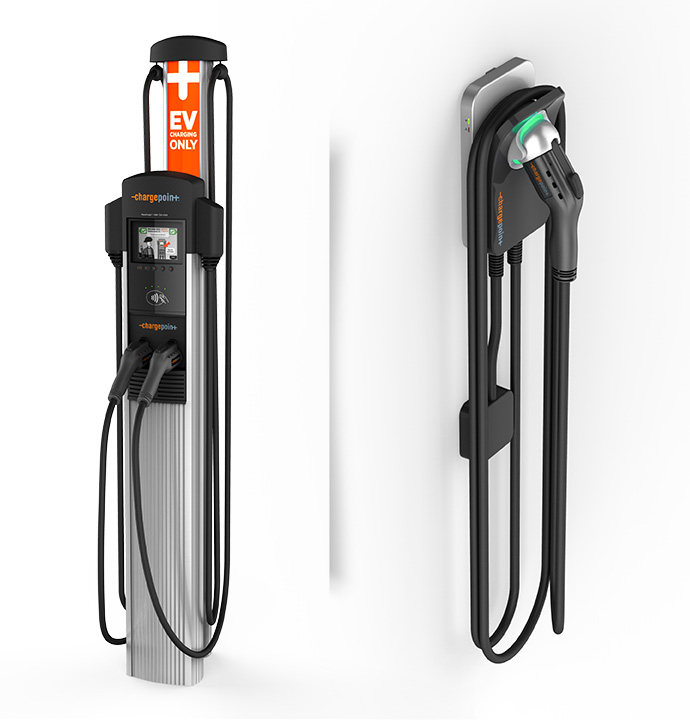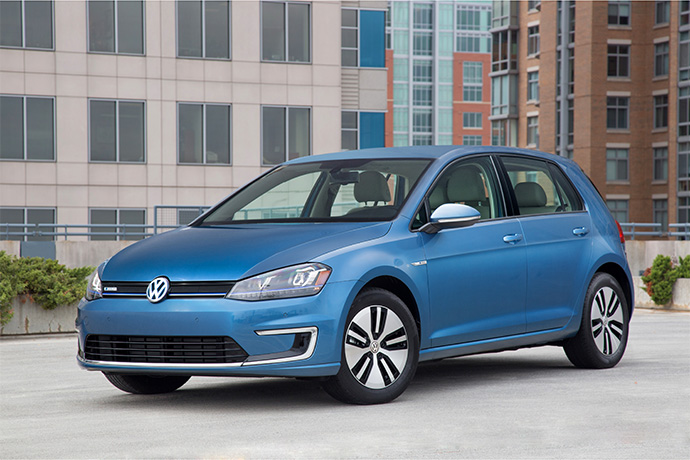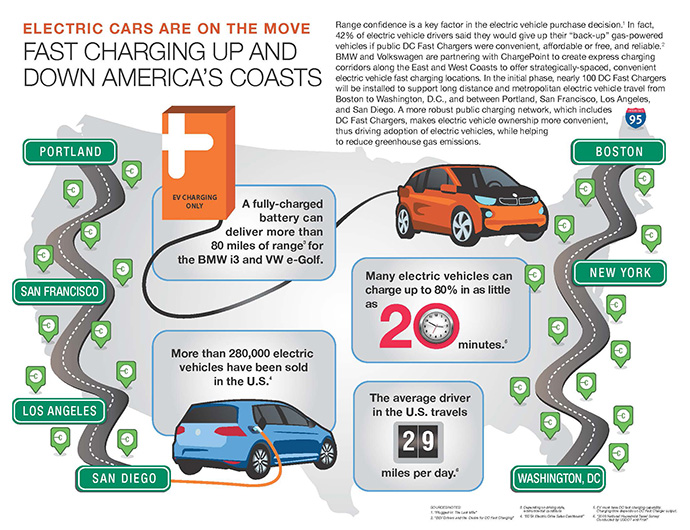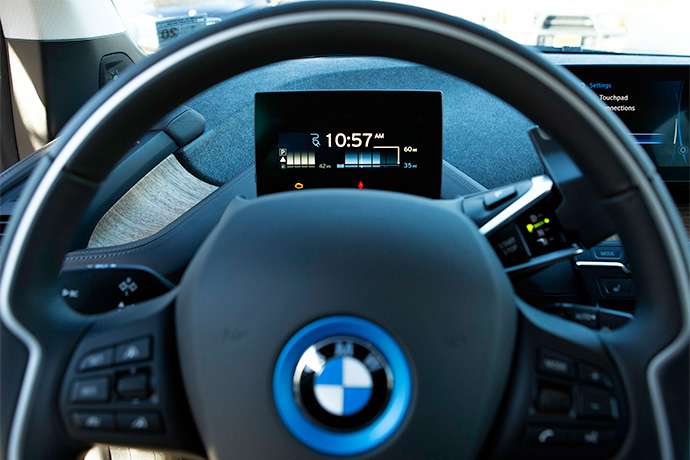
Think “network coverage” and what usually comes to mind are mobile phones or monumental news events.
But the phrase is gradually becoming part of the lexicon of a growing demographic: electric vehicle owners looking for juice. And efforts to make those drivers more mobile are making news.
At the Washington Auto Show in January, Volkswagen of America and BMW of North America, together with ChargePoint, the largest electric vehicle charging network, announced an initiative to create express charging corridors along heavily-traveled routes on the East and West Coasts.
Designed to increase the number of fast charging locations, the initiative will help meet the large and growing demand for convenient, publicly available electric vehicle fast chargers, including direct current (DC) Fast charging locations. In the initial phase, the aim is to install nearly 100 DC Fast chargers across both coasts, with plans to expand the program to increase access to fast charging across the country. These newly installed DC Fast chargers will be added to the growing ChargePoint network of more than 20,000 charging spots in North America.
“With more than 280,000 electric vehicles sold in the United States, EV owners need more charging flexibility while on the go,” said the companies’ release. “The express charging corridors will provide electric vehicle drivers access to DC Fast chargers along the most heavily populated and highly-trafficked regions on Interstate 95 on the east coast, from Boston to Washington, D.C., and on the West Coast covering and connecting the metropolitan areas of Portland, San Francisco, Los Angeles, and San Diego. The installations will occur both within and between relevant metro areas, strategically-spaced at a maximum of 50 miles apart, making it even easier to take long road trips in an EV.”
The ChargePoint installations have already begun on the West Coast, with the first location in San Diego County. There is a target of nearly 100 DC Fast charging spots in the first phase, available by the end of 2015. DC Fast chargers along the express charging corridors are expected to be installed in convenient locations such restaurants, shopping centers, rest stops, and more. ChargePoint will leverage its existing customer base and knowledge on usage to pick strategic locations either where drivers currently charge, or to fill in spaces where there is currently a lack of infrastructure.
When charging at a 50 kW station, both the BMW i3 and the Volkswagen e-Golf can charge up to 80 percent in 20 minutes. Both vehicles can charge up to 80 percent in 30 minutes at a 24-kW station. Locations will also include Level 2 chargers, currently the most commonly available public charging stations, which are compatible with all electric vehicles. Level 2 stations can dispense up to 25 miles of range per hour of charging.

“The express charging corridors are another important step in the development of the U.S. e-mobility infrastructure that makes longer distance travel a real option for consumers, particularly along the most heavily trafficked portions of both coasts — making the BMW i3 and other electric vehicles even more appealing,” said Robert Healey, head of EV Infrastructure at BMW of North America.
Earlier in January, to help complete the circle among smart homes, smart cars and smart phones, ChargePoint unveiled a new home EV charging station for the first time, expected to be on the market by summertime. The charger plugs into a standard 240V outlet and has a universal J1772™ connector that is compatible with all cars and can be installed either indoors or outdoors. Drivers can charge up to 25 miles per hour and manage the charger from their smartphones.
In making the announcement in DC, Pasquale Romano, ChargePoint CEO, said, “Our goal at ChargePoint is to get everyone behind the wheel of an EV and provide EV charging everywhere they go. With strategically placed stations where drivers need them, these express charging corridors will give EV drivers the freedom to go farther and have an EV as their only car without limitation.”
Wait: What About the Midwest?
Wondering how that infrastructure is measuring up in your area. The US. Dept. of Energy’s Alternative Fuels Data Center maintains a running record of where to go, and it’s evident that the coasts already have the most.
But four days after the big news about the coastal corridors, ChargePoint scored points in the Midwest, as Kansas City Power & Light Company (KCP&L), a subsidiary of Great Plains Energy Incorporated announced plans to install and operate more than 1,000 EV charging stations, also manufactured by ChargePoint, throughout the Greater Kansas City area, making it the largest such installation by an electric utility in the United States, capable of supporting more than 10,000 EVs.
“The Kansas City region is quickly building a reputation as an innovative, sustainable place to live and work,” said Terry Bassham, president and CEO of Great Plains Energy and KCP&L. “We’re excited to continue being a leader in support of this growth by providing our customers and visitors to this region with an environmentally-friendly alternative to gasoline-powered vehicles.”
“The most exciting part is that everyone benefits,” said Kansas City Mayor Sly James. “Not only do the owners of electric vehicles in Kansas City benefit, but with this project, KCP&L is also investing in the economic development and environmental sustainability of this region, which is a win for everyone.”
In addition to regional economic and environmental benefits, the Clean Charge Network can help keep electricity costs low for all KCP&L customers, said the utility: “As more drivers adopt electric vehicles, not only will vehicle emissions be reduced but the cost of operating and maintaining the electrical grid will be spread over increased electricity usage, benefiting everyone. Those who drive electric vehicles will see the bill for fueling their cars go down because electricity is less expensive than gasoline, even at gasoline’s low current price. At the same time, increased efficient use of electricity will offset cost increases for operating the grid, which would otherwise become part of customer bills.”
“People generally charge their cars at non-peak periods when KCP&L’s electrical grid is being underutilized. By stimulating electric vehicle adoption with their Clean Charge Network, what KCP&L is doing is encouraging people to use the electrical grid more efficiently and drive down the cost of electricity for everyone,” said Natural Resources Defense Council Senior Energy Economist Ashok Gupta.
Station location requires a site selection strategy all its own. Host sites have been selected using a variety of criteria, including ensuring KCP&L’s Clean Charge Network is accessible at geographically diverse sites that are convenient for customers to access. “There are still a limited number of spots available for sites,” said the utility on Jan. 26. “Interested business can apply online at www.kcpl.com/CleanCharge. Customers who would like to nominate a location can do so on KCP&L’s Facebook page at www.facebook.com/KCPLConnect.”


